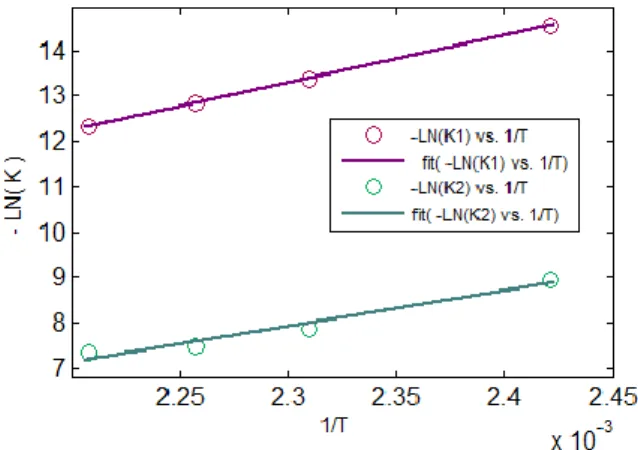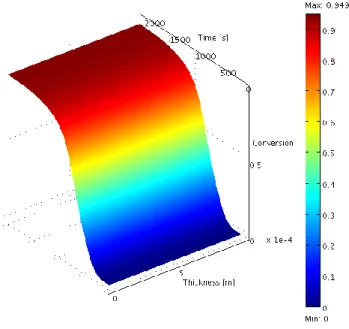____________________
* F.M. Schmidt : Schmidt@mines-albi.fr
CURING SIMULATION OF COMPOSITES COUPLED WITH INFRARED
HEATING
S. Nakouzi, J. Pancrace, F.M. Schmidt*, Y. Le Maoult, F. Berthet
Université de Toulouse ; INSA, UPS, Mines Albi, ISAE ; ICA (Institut Clément Ader); Campus
Jarlard, F-81013 Albi cedex 09, France
Ecole des Mines Albi, Campus Jarlard, F-81013 Albi, France
ABSTRACT : Because of higher specific strength and stiffness, low weight, and good resistance to corrosion, the use
of composite materials in aerospace structures has increased. Aircraft industry has recently begun to investigate Liquid Composites Molding techniques (LCM) through research programs because of its ability to produce large parts at a low cost. In this paper, we have not addressed the filling step during which the resin flows through fibrous media, but we investigate the numerical simulation of curing reinforced RTM-6 by infrared heating. A ray tracing in-lab software called RAY-HEAT is used to compute the radiation energy due to the interaction between reinforced RTM-6 and lamps. Finite element based program COMSOL Multiphysics™ has been used to simulate the curing process. Thermochemical model has been implemented in order to compute reaction rate as a function of reaction temperature and degree of conversion using a cure kinetic model .
KEYWORDS: polymer composite, infrared heating, degree of cure, epoxy resin, graphite/epoxy, modeling.
1 INTRODUCTION
Using thermal radiation to cure the composite is more efficient, effective, and clean than standard thermal energy sources. Thermal radiation was successfully used to produce a high quality polymer matrix in less time [1]. The infrared radiation was studied and coupled with the energy equation and the exothermic heat released during the curing process in order to predict the composite temperature as a function of time and degree of cure.
2 INFRARED INTERACTION
Because the graphite fibers embedded in the epoxy resin are very strong infrared absorbers over broad spectral ranges at all wavelengths, the composite has strong absorption bands in some portions of the spectrum; we have neglected epoxy absorption in this paper [1, 2, 3, 4].
2.1 BOUNDARY CONDITIONS
The composite is assumed to be a block with a thickness range of 1-25mm. It is composed of the superposition of a sequence of carbon plies embedded in an epoxy matrix [5].
Figure 1: .Schematic presentation of the composite [6].
The infrared radiation is absorbed by the carbon ply present in the top surface of the composite. The boundary conditions taken in COMSOL MultiphysicsTM are a surface incident heat flux on the top surface. There is also natural heat convection between this surface and the air present in the oven. The other boundaries are assumed to be adiabatic: the bottom surface is in contact with a mould and there is no heat exchange between the mould and the composite. The other sides of the composite are so thin in comparison with the top that they can be considered adiabatic.
3 ENERGY EQUATION
The composite transient temperature can be evaluated by the Fourier’s modal equation assuming an instantaneous equilibrium temperature between the resin and the fibers at each time: [7,8]
(1)
Where = ultimate heat of reaction, = degree of cure,
and the , ,
thermal conductivity of the composite are expressed using the rule of mixture:[8, 9, 10]
(2) (3) (4)
(5) (6)
Where = transverse thermal conductivity of the fibers, weight fraction, = volume fraction, the subscript stands for the fibers, and for the matrix. The system of equations described above can be solved at each time step in order to calculate the distributions of temperature and degree of cure and their evolution with time.
4 KINETIC MODELING
4.1 GLASS TRANSITION TEMPERATURE
The glass transition temperature is modelled using the DiBenedetto equation:[9]
Where and = glass transition temperature of un-reacted and full-un-reacted resin, = material constant. These values were deduced from the literature [8].
4.2 KINETIC MODEL
Kamal and Sourour [7] have shown that the following model adequately describes the cure kinetics of an epoxy resin:
Where and = rate constants with an Arrhenius type of dependence with temperature and and = catalytic constants.
Although the model of Kamal and Sourour [6] contains several essential features, it ignores the influence of the glass transition temperature on the diffusion of the macromolecules.
This model [7]
has
been extended in order to reflect the effect of vitrification in the kinetic model of resin transfer molding. This model was also used by [8]
[11]
Where = diffusion factor, = diffusion rate constant, = constant having the order of one, = glass transition temperature, the free volume fraction of the polymer[11], = the free volume fraction for a temperature equal to , = the thermal expansion coefficient for a temperature above .
For an amorphous polymer [10] which is the case of our
composite, and .
4.3 KINETIC PARAMETERS
Kinetic parameters of RTM6 resin are calculated using linear regression algorithms by fitting model equations with the Differential Scanning Calorimeter experimental data. These experimental DSC data were scanned isothermally for different temperatures: 140, 160, 170 and 180°C.
In the DSC, the rate of heat generation is recorded with time. As is constant for a given curing process, [7, 8, 12] the rate of the degree of cure is calculated by:
The degree of cure is obtained by integrating the DSC data and normalizing with
.
4.4 FITTED KINETIC PARAMETERS
The figure 2 below shows the temperature dependence of factors and which exhibits an Arrhenius type of temperature dependence.
Figure 2: Reaction rate constants k1 and k2.
The estimated kinetics parameters from the fitting curves used in our simulations are listed in table 1 below.
Table 1: Estimated parameters
parameter [ ] 4.5E6 [ ] 74.69E4 [ ] 1.3E6 [ ] 58.37E4 [ ] 85.2E28 [ ] 2.16E5 [-] 1.23 [-] 1.36 [-] 0.227 [J/kg] 4.30E5 R [J/(mol-K)] 8.314
5 NUMERICAL EXAMPLE
The carbon fibers embedded in the epoxy are very strong absorbers in that they absorb infrared energy and convert this energy to heat the epoxy matrix surrounding the carbon fibers. Thermal radiative boundary conditions are imposed on the top surface of the composite and the curing temperature is controlled through the infrared emitters in order to optimize a uniform surface heat flux. The emitters used in our project are halogen lamps given from TOSCHIBA LIGNTNING.
Until now, the composite properties were taken from the literature [1, 9]; others are assumed to be constants in order to run some initial simulations of a curing process of RTM6 as a matrix combined with a fibrous reinforcement in the form of carbon plies.
In this numerical example, a high heat flux of was provided for the first 6 minutes in order to initiate and accelerate resin curing, and for the rest of time, the surface heat flux taken was
These heat flux values was imposed in a way to cure the composite in a less time and do not exceed 220°C in temperature (the degradation temperature of the matrix).
Figure 3: Schematic presentation of the composite face
to the infrared emitters.
5.1 NUMERICAL RESULTS
Using COMSOL Multiphysics, the energy equation was coupled with the exothermic reaction in order to predict the temperature distribution in the composite and the degree of cure.
The figures 4 and 5 below show the temperature and the degree of curing respectively evolution with time at the center of the composite.
Figure 4: Temperature evolution with time at the center
of the composite
Figure 5: Degree of cure evolution with time at the center
of the composite
The figures 6 and 7 below show the temperature and degree of cure respectively evolution with time and thickness of the composite.
Figure 6: Temperature evolution with thickness and with
Figure 7: Degree of cure evolution with thickness and
with time
These numerical simulations correspond for a 1mm thickness composite; there is no important variation of the temperature or degree of cure with the thickness. From these simulations, we can deduce that the cure of the composite is accomplished in a less time than the others modes of heating.
In the future work, we need to validate our numerical simulations with experimental infrared curing.
6 CONCLUSIONS
The cure model of resin is investigated in this study. A modification of the Kamal-Sourour cure model is given to account for the diffusion effect. Kinetic parameters of the cure model based on DSC Experiments were estimated using optimization algorithms. A thermal-kinetic model has been developed in COMSOL Multiphysics to simulate the cure process of pure resin with assumed material properties. In-lab software developed to predict the infrared heat flux on the top surface of the composite will be coupled with COMSOL in order to simulate the whole infrared curing process of the composite.
ACKNOWLEDGEMENT
The authors would like to thank Mr. Goyot D. for his support. Grateful acknowledgement to TOSCHIBA LIGHTNING for their financial support and their attention to this work.
REFERENCES
[1] Chern B.C, Moon T. J., Howell J. R.: On-Line Processing of Unidirectional Fiber Composites Using Radiative Heating: I. Model. Journal of
Composite Materials , 36,1905,2002
[2] Chern B.C, Moon T. J., Howell J. R.: On-Line Processing of Unidirectional Fiber Composites Using Radiative Heating: II. Radiative Properties, Experimental Validation and Process Parameter Selection. Journal of Composite Materials , 36, 1935, 2002
[3] Kim J., Moon T. J., Howell J. R.: Transient Thermal Modeling of In-Situ Curing During Tape Winding of Composite Cylinders. Journal of Heat Transfer, 125-137, 2003
[4] Chern B.C, Moon T. J., Howell J. R.: Thermal Analysis of In-Situ Curing for Thermoset, Hoop-Wound Structures Using Infrared Heating: Part II – Dependent Scattering Effect. Journal of Heat
Transfer, 117-681, 1995
[5] Cunningham E., Monaghan P. F. and Brogan M. T.: Prediction of the temperature profile with a composit sheets during pre-heating. Composite part A. 51-61, 1998.
[6] Zebdi O.,Boukhili R. and Trochu F .: An Inverse Approach Based on Laminate Theory to Calculate the Mechanical Properties of Braided Composites. Journal of Reinforced Plastics and Composites OnlineFirst ,2008
[7] Bailleul J. L., Guyonvarch G., Garnier B., Jarny Y., and Delaunay D.: Identification des propriétés thermiques de composites fibres de verre / résines thermodurcissables Application a l’optimisation des
procédés de moulage. Revue Générale Thermique,
36, 65-77, 1996
[8] Ruiz E. and Trochu F.: Thermomechanical Properties during Cure of Glass-Polyester RTM Composites: Elastic and Viscoelastic Modeling.
Journal of Composite Materials, 39; 881, 2005
[9] Ruiz E. and Trochu F.: Multi-criteria thermal optimization in liquid composite molding to reduce processing stresses and cycle time. Composites: Part A 37, 913-924,2006
[10] Balvers J.M., Bersee H.E.N., Beukers A., K.M.B. Jansen: Determination of Cure Dependent Properties for Curing Simulation of Thick-Walled Composites. In: 49th AIAA/ASME/ASCE/AHS/ASC Structures, Structural Dynamics, and Materials Conference, 2008.
[11] Nguyen T. M. H. : Systèmes époxy-amines incluant un catalyseur externe phénolique : Cinétique de réticulation- vieillissement hydrolytique, 2007. [12] I. Elsawi, P. Olivier, P. Demont, C. Laurent, A.
Peigney: Rheological and kinetic behavior of double-walled carbon nanotubes filled epoxy resin. JNC 16 Toulouse, 2009.


